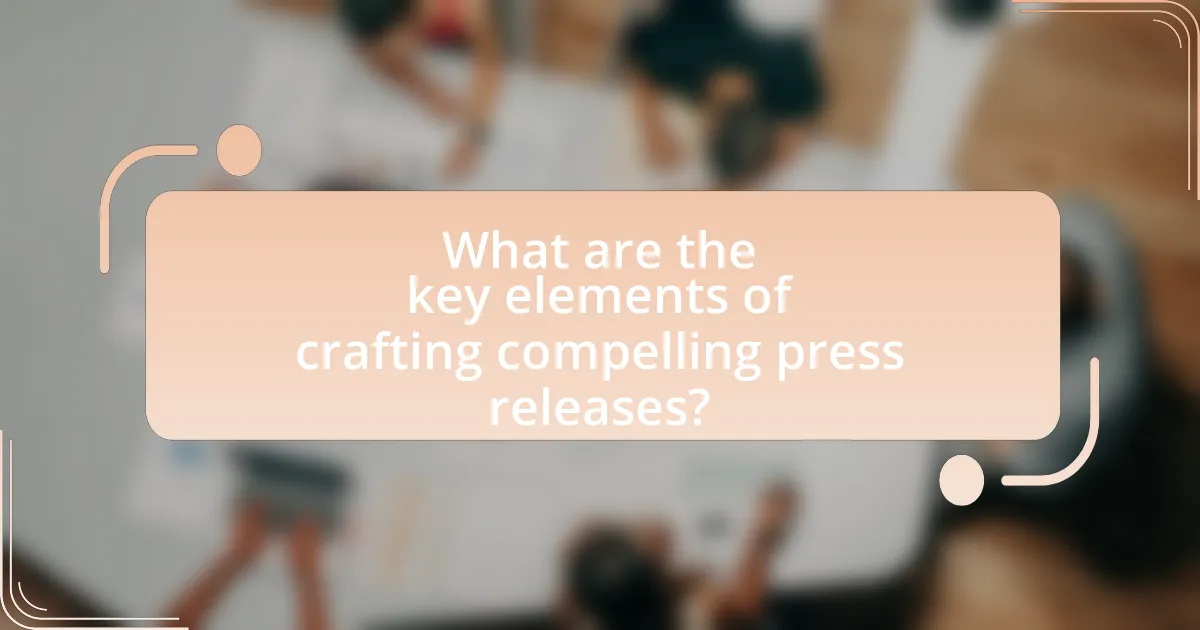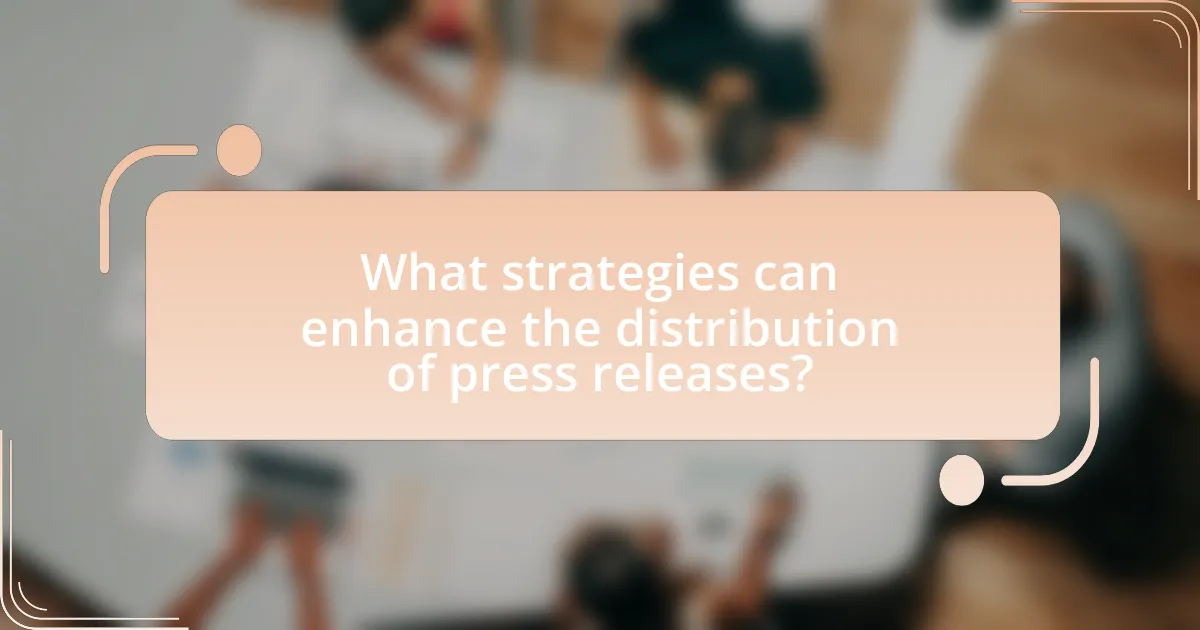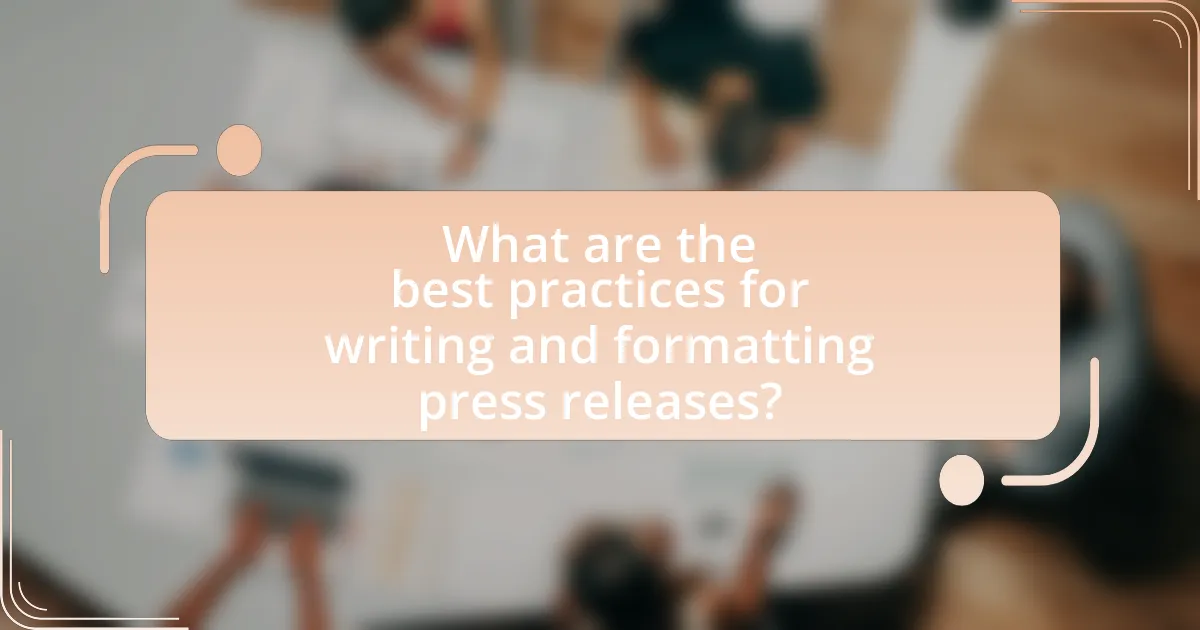The article focuses on the essential elements of crafting compelling press releases, emphasizing the importance of a strong headline, engaging lead paragraph, concise body content, relevant quotes, and a boilerplate. It highlights how effective headlines can capture attention and influence media coverage, while the lead paragraph summarizes critical information to engage readers. The body of the press release elaborates on the news, structured in an inverted pyramid format for clarity. Additionally, the article discusses strategies for optimizing distribution, targeting the right audience, and adhering to best practices in writing and formatting to enhance communication effectiveness.

What are the key elements of crafting compelling press releases?
The key elements of crafting compelling press releases include a strong headline, an engaging lead paragraph, clear and concise body content, relevant quotes, and a boilerplate. A strong headline captures attention and summarizes the news, while the lead paragraph provides essential information, answering the who, what, when, where, and why. The body content should be concise and informative, elaborating on the details without unnecessary jargon. Including relevant quotes from key stakeholders adds credibility and a human element to the release. Finally, a boilerplate offers background information about the organization, providing context for the reader. These elements collectively enhance the effectiveness of a press release in communicating news to the media and the public.
How do headlines impact the effectiveness of a press release?
Headlines significantly impact the effectiveness of a press release by determining the initial engagement and interest of the audience. A compelling headline captures attention, encourages further reading, and can influence the likelihood of media coverage. Research indicates that 80% of readers only read headlines, emphasizing the need for clarity and relevance in headline creation. Effective headlines often include keywords that enhance searchability, making the press release more accessible to journalists and the public. Thus, a well-crafted headline is crucial for maximizing the reach and impact of a press release.
What makes a headline attention-grabbing?
An attention-grabbing headline is characterized by its clarity, emotional appeal, and specificity. Clarity ensures that the message is easily understood, while emotional appeal engages the reader’s feelings, prompting curiosity or urgency. Specificity provides concrete details that make the headline more relatable and informative. Research indicates that headlines with numbers or questions tend to attract more clicks, as they promise clear takeaways or provoke thought. For instance, a study by the Content Marketing Institute found that headlines with numbers can increase engagement by up to 36%.
How can headlines be optimized for SEO?
Headlines can be optimized for SEO by incorporating relevant keywords, maintaining a clear and concise structure, and ensuring they are engaging to attract clicks. Using targeted keywords that reflect the content of the press release helps search engines understand the topic, while a concise structure, ideally under 60 characters, ensures visibility in search results. Engaging headlines that evoke curiosity or provide value can increase click-through rates, which is a factor in SEO rankings. According to a study by HubSpot, headlines with numbers or questions tend to perform better, indicating that specific formats can enhance engagement and SEO effectiveness.
Why is the lead paragraph crucial in a press release?
The lead paragraph is crucial in a press release because it summarizes the most important information and captures the reader’s attention immediately. This paragraph typically answers the who, what, when, where, why, and how of the news being announced, providing a concise overview that encourages further reading. Research indicates that journalists often decide whether to pursue a story based on the lead paragraph, making it essential for effective communication and media engagement.
What information should be included in the lead paragraph?
The lead paragraph of a press release should include the most critical information: the who, what, when, where, and why of the announcement. This concise summary captures the essence of the news and engages the reader immediately. For instance, a study by the Public Relations Society of America emphasizes that a strong lead paragraph can significantly increase media interest and coverage, highlighting its importance in effective communication strategies.
How can the lead paragraph engage the reader?
The lead paragraph can engage the reader by presenting a compelling hook that captures attention immediately. This can be achieved through the use of a strong, relevant statement or a provocative question that resonates with the audience’s interests or concerns. For instance, research indicates that press releases with engaging leads increase reader retention by up to 50%, highlighting the importance of a well-crafted opening. By addressing the reader’s needs or emotions right from the start, the lead paragraph sets the tone for the rest of the content, encouraging further reading and engagement.
What role does the body of the press release play?
The body of the press release serves to convey the essential information and key messages about the news being announced. It elaborates on the headline and lead, providing details such as the who, what, when, where, why, and how of the story. This section is crucial because it engages the reader, offering context and supporting facts that validate the announcement. For instance, a well-structured body can include quotes from relevant stakeholders, statistics, or background information that enhances the credibility of the release and captures the interest of journalists and the target audience.
How should information be structured in the body?
Information in the body of a press release should be structured using the inverted pyramid format, where the most critical information appears first, followed by supporting details and background information. This approach ensures that readers quickly grasp the essential message, as studies show that journalists often skim content for key points. For instance, the lead paragraph should contain the who, what, when, where, why, and how of the news, while subsequent paragraphs can elaborate on details, quotes, and context. This structure aligns with industry standards, as evidenced by the Associated Press style guidelines, which emphasize clarity and conciseness in news writing.
What techniques can enhance the body content?
Techniques that can enhance body content in press releases include using clear and concise language, incorporating relevant statistics, and employing storytelling elements. Clear language ensures that the message is easily understood, while relevant statistics can provide credibility and support claims, such as citing that press releases with data are 30% more likely to be picked up by media outlets. Additionally, storytelling elements can engage readers by creating a narrative that resonates with them, making the content more memorable and impactful.

What strategies can enhance the distribution of press releases?
Utilizing targeted media lists enhances the distribution of press releases by ensuring that the content reaches relevant journalists and outlets. Tailoring the press release to specific audiences increases the likelihood of coverage, as studies show that personalized pitches yield higher response rates. Additionally, leveraging social media platforms for distribution broadens the reach, with 79% of journalists using social media to discover news. Incorporating multimedia elements, such as images and videos, can also improve engagement, as press releases with visuals receive 94% more views. Finally, optimizing press releases for search engines increases visibility, as 70% of online experiences begin with a search engine.
How can targeting the right audience improve press release effectiveness?
Targeting the right audience significantly enhances press release effectiveness by ensuring that the message reaches individuals who are most likely to engage with it. When press releases are directed towards a specific demographic or interest group, the likelihood of media coverage and audience interaction increases, as these individuals are more inclined to find the content relevant and valuable. For instance, a study by the Public Relations Society of America found that targeted press releases can lead to a 50% increase in media pick-up rates compared to generic releases. This targeted approach not only improves visibility but also fosters stronger relationships with key stakeholders, ultimately driving better outcomes for the organization.
What methods can be used to identify the target audience?
To identify the target audience, methods such as market research, surveys, social media analytics, and customer segmentation can be employed. Market research involves analyzing industry trends and consumer behavior to understand potential audiences. Surveys collect direct feedback from existing or potential customers, providing insights into their preferences and demographics. Social media analytics tools track engagement metrics and audience interactions, revealing who is most interested in the content. Customer segmentation categorizes audiences based on shared characteristics, allowing for tailored messaging. These methods are validated by their widespread use in marketing strategies, demonstrating their effectiveness in accurately identifying target audiences.
How does audience segmentation affect messaging?
Audience segmentation significantly influences messaging by allowing tailored communication that resonates with specific groups. When organizations segment their audience based on demographics, interests, or behaviors, they can craft messages that address the unique needs and preferences of each segment. For instance, a study by the Content Marketing Institute found that 72% of marketers believe that audience segmentation leads to higher engagement rates. This demonstrates that targeted messaging, informed by audience segmentation, enhances the effectiveness of communication strategies, particularly in press releases.
Why is timing important in press release distribution?
Timing is crucial in press release distribution because it directly influences the visibility and impact of the announcement. Releasing a press release at a strategically chosen time can maximize media coverage and audience engagement. For instance, studies show that press releases distributed on weekdays, particularly Tuesday through Thursday, receive higher open rates compared to those sent on weekends. Additionally, aligning the release with relevant news cycles or industry events can enhance its relevance, making it more likely to be picked up by journalists and media outlets. This strategic timing ensures that the press release reaches the target audience when they are most receptive, thereby increasing the chances of achieving the desired communication goals.
What factors should be considered when choosing a distribution time?
When choosing a distribution time for a press release, factors such as audience availability, industry trends, and news cycle timing should be considered. Audience availability ensures that the press release reaches the target demographic when they are most likely to engage, typically during weekdays and business hours. Industry trends indicate that certain sectors may have peak times for news consumption, such as tech announcements during major conferences. Additionally, aligning with the news cycle, such as avoiding major holidays or significant events that could overshadow the release, is crucial for maximizing visibility. Research shows that press releases sent on Tuesdays and Wednesdays often achieve higher engagement rates, reinforcing the importance of timing in distribution strategies.
How can current events influence press release timing?
Current events can significantly influence press release timing by creating a sense of urgency or relevance that aligns with public interest. For instance, if a major news story breaks that relates to a company’s industry, releasing a press statement shortly thereafter can capitalize on heightened media attention and audience engagement. Historical examples include companies announcing product launches or corporate initiatives in response to events like natural disasters or economic shifts, which can enhance visibility and impact. This strategic timing ensures that the press release is more likely to be picked up by journalists and shared across platforms, thereby maximizing its reach and effectiveness.

What are the best practices for writing and formatting press releases?
The best practices for writing and formatting press releases include using a clear and concise headline, providing essential information in the first paragraph, and maintaining an inverted pyramid structure. A clear headline captures attention and summarizes the news, while the first paragraph should answer the who, what, when, where, why, and how of the story. The inverted pyramid structure allows readers to grasp the most critical information first, followed by supporting details.
Additionally, press releases should be written in a professional tone, free of jargon, and include quotes from key stakeholders to add credibility. Formatting should include the date and location at the top, followed by the body text, and end with a boilerplate that provides background information about the organization. Including contact information for media inquiries is also essential. These practices ensure that press releases are effective in communicating news to journalists and the public.
How can clarity and conciseness improve a press release?
Clarity and conciseness significantly enhance a press release by ensuring that the key messages are easily understood and quickly grasped by the target audience. When a press release is clear, it eliminates ambiguity, allowing readers to comprehend the essential information without confusion. Conciseness further aids in retaining the reader’s attention, as it presents information in a straightforward manner, reducing the likelihood of losing interest. Research indicates that press releases that are succinct and to the point have a higher chance of being read and shared, as they respect the time constraints of journalists and readers alike. Therefore, clarity and conciseness not only improve comprehension but also increase the likelihood of media coverage and audience engagement.
What techniques can be used to maintain clarity in writing?
To maintain clarity in writing, techniques such as using simple language, structuring content logically, and employing active voice are essential. Simple language reduces ambiguity, making it easier for readers to understand the message. Logical structure, including clear headings and bullet points, helps guide readers through the content systematically. Active voice enhances directness and engagement, making sentences more straightforward. Research indicates that clarity in writing significantly improves reader comprehension and retention, as evidenced by studies showing that readers prefer concise and well-organized information.
How does conciseness affect reader engagement?
Conciseness significantly enhances reader engagement by delivering information quickly and clearly. When content is concise, readers can grasp key messages without unnecessary distractions, leading to improved comprehension and retention. Research indicates that concise writing increases the likelihood of readers finishing the material; for instance, a study published in the Journal of Business Communication found that concise messages are 30% more likely to be read in full compared to verbose ones. This demonstrates that brevity not only captures attention but also sustains it, making conciseness a crucial element in crafting effective press releases.
What common mistakes should be avoided in press releases?
Common mistakes to avoid in press releases include using jargon, failing to include a strong lead, and neglecting to provide contact information. Jargon can alienate readers and obscure the message, while a weak lead fails to capture attention, diminishing the likelihood of media coverage. Additionally, omitting contact information prevents journalists from reaching out for further details, which can hinder the effectiveness of the release. According to a study by the Public Relations Society of America, 70% of journalists reported that a clear and concise lead is crucial for their interest in a press release.
How can jargon and technical language hinder communication?
Jargon and technical language can hinder communication by creating barriers to understanding for audiences unfamiliar with specific terminology. When press releases use specialized language, they risk alienating readers who may not grasp the intended message, leading to misinterpretation or disengagement. Research indicates that clear communication enhances audience comprehension; for instance, a study by the Nielsen Norman Group found that users prefer simple language, which improves information retention and engagement. Therefore, excessive jargon can diminish the effectiveness of press releases by obscuring key messages and reducing audience reach.
What are the pitfalls of excessive length in press releases?
Excessive length in press releases can lead to decreased reader engagement and reduced clarity. When press releases are too long, they risk overwhelming the audience with information, causing key messages to be lost. Research indicates that journalists typically prefer concise press releases, with optimal lengths around 400 words, as longer documents may not be fully read or may be discarded. Additionally, lengthy press releases can dilute the impact of the main news, making it harder for readers to grasp the essential points quickly. This can ultimately hinder media coverage and diminish the effectiveness of the communication.
What practical tips can help in crafting compelling press releases?
To craft compelling press releases, focus on clarity, relevance, and a strong lead. Start with a clear headline that summarizes the main news, followed by a concise lead paragraph that answers the who, what, when, where, why, and how. Use quotes from key stakeholders to add credibility and human interest. Ensure the content is newsworthy by highlighting unique angles or timely relevance. Incorporate multimedia elements, such as images or videos, to enhance engagement. Finally, include a boilerplate that provides background information about the organization, ensuring it is easy for journalists to understand the context. These strategies are supported by industry standards, which emphasize the importance of clear communication and engaging storytelling in press releases.
How can storytelling be incorporated into press releases?
Storytelling can be incorporated into press releases by framing the information within a narrative that highlights the human element or emotional impact of the news. This approach engages readers more effectively than straightforward facts, as it creates a connection and makes the content memorable. For instance, including a customer testimonial or a case study can illustrate the significance of the announcement, making it relatable and compelling. Research shows that narratives can increase information retention by up to 65%, demonstrating the effectiveness of storytelling in communication.
What resources are available for further learning on press release writing?
Resources available for further learning on press release writing include online courses, books, and industry websites. For instance, platforms like Coursera and Udemy offer courses specifically focused on press release writing, providing structured learning and practical examples. Books such as “The New Rules of Marketing and PR” by David Meerman Scott offer insights into effective press release strategies. Additionally, websites like PR Newswire and PRWeb provide articles and guides that cover best practices and current trends in press release writing, making them valuable resources for anyone looking to enhance their skills in this area.